Human Resource Management Challenges and Strategies at Bank of England
VerifiedAdded on 2022/12/09
|14
|3705
|456
Report
AI Summary
This report provides a comprehensive analysis of human resource management (HRM) issues at the Bank of England. It begins with an introduction to the bank and its significance, followed by an examination of key HRM challenges, particularly those related to employee training and development. The report delves into the workplace context, outlining the bank's objectives, organizational culture, and values. It also addresses relevant global factors, including cultural differences and diversity. The main body of the report includes an analysis of the chosen HRM issues, the workplace context, and the application of SMART goals. The report highlights the importance of effective training programs, addressing the challenges of geographically dispersed employees and generational differences in the workforce. The report also discusses strategies to improve employee engagement and customize training according to specific roles. The report concludes by summarizing the key findings and recommendations for the Bank of England's HRM practices.

Human Resources Management
Paraphrase This Document
Need a fresh take? Get an instant paraphrase of this document with our AI Paraphraser
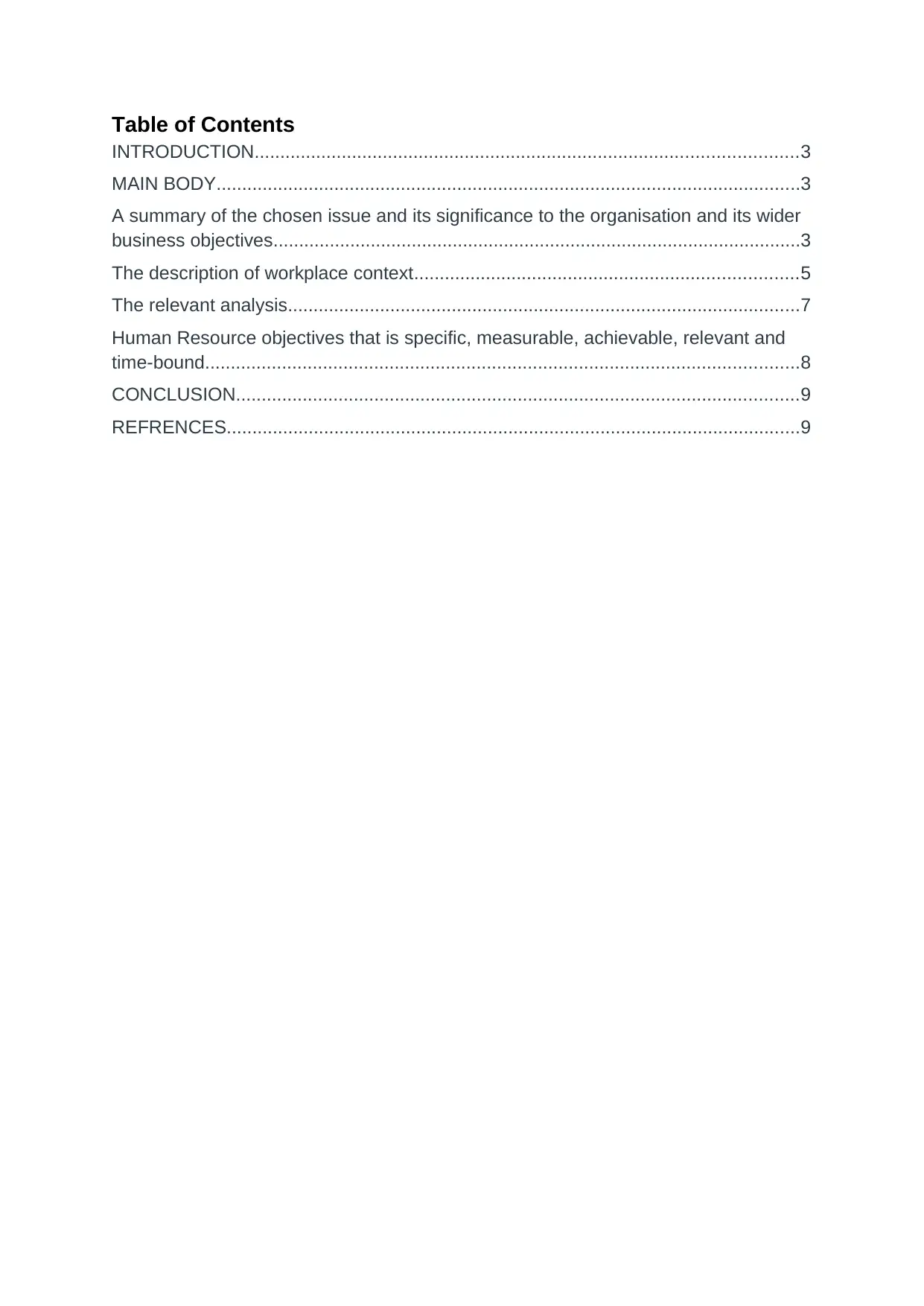
Table of Contents
INTRODUCTION..........................................................................................................3
MAIN BODY..................................................................................................................3
A summary of the chosen issue and its significance to the organisation and its wider
business objectives.......................................................................................................3
The description of workplace context...........................................................................5
The relevant analysis....................................................................................................7
Human Resource objectives that is specific, measurable, achievable, relevant and
time-bound....................................................................................................................8
CONCLUSION..............................................................................................................9
REFRENCES................................................................................................................9
INTRODUCTION..........................................................................................................3
MAIN BODY..................................................................................................................3
A summary of the chosen issue and its significance to the organisation and its wider
business objectives.......................................................................................................3
The description of workplace context...........................................................................5
The relevant analysis....................................................................................................7
Human Resource objectives that is specific, measurable, achievable, relevant and
time-bound....................................................................................................................8
CONCLUSION..............................................................................................................9
REFRENCES................................................................................................................9
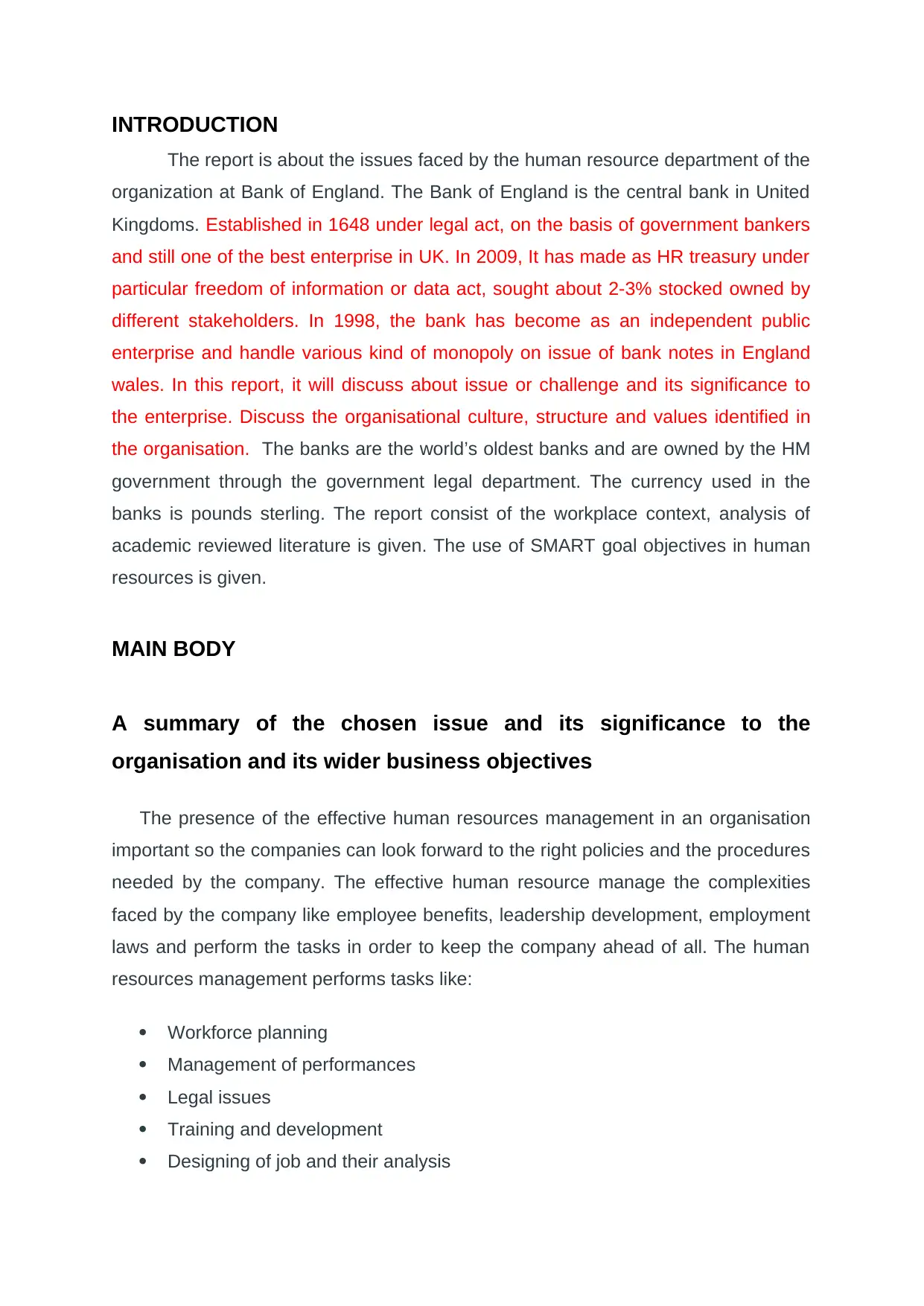
INTRODUCTION
The report is about the issues faced by the human resource department of the
organization at Bank of England. The Bank of England is the central bank in United
Kingdoms. Established in 1648 under legal act, on the basis of government bankers
and still one of the best enterprise in UK. In 2009, It has made as HR treasury under
particular freedom of information or data act, sought about 2-3% stocked owned by
different stakeholders. In 1998, the bank has become as an independent public
enterprise and handle various kind of monopoly on issue of bank notes in England
wales. In this report, it will discuss about issue or challenge and its significance to
the enterprise. Discuss the organisational culture, structure and values identified in
the organisation. The banks are the world’s oldest banks and are owned by the HM
government through the government legal department. The currency used in the
banks is pounds sterling. The report consist of the workplace context, analysis of
academic reviewed literature is given. The use of SMART goal objectives in human
resources is given.
MAIN BODY
A summary of the chosen issue and its significance to the
organisation and its wider business objectives
The presence of the effective human resources management in an organisation
important so the companies can look forward to the right policies and the procedures
needed by the company. The effective human resource manage the complexities
faced by the company like employee benefits, leadership development, employment
laws and perform the tasks in order to keep the company ahead of all. The human
resources management performs tasks like:
Workforce planning
Management of performances
Legal issues
Training and development
Designing of job and their analysis
The report is about the issues faced by the human resource department of the
organization at Bank of England. The Bank of England is the central bank in United
Kingdoms. Established in 1648 under legal act, on the basis of government bankers
and still one of the best enterprise in UK. In 2009, It has made as HR treasury under
particular freedom of information or data act, sought about 2-3% stocked owned by
different stakeholders. In 1998, the bank has become as an independent public
enterprise and handle various kind of monopoly on issue of bank notes in England
wales. In this report, it will discuss about issue or challenge and its significance to
the enterprise. Discuss the organisational culture, structure and values identified in
the organisation. The banks are the world’s oldest banks and are owned by the HM
government through the government legal department. The currency used in the
banks is pounds sterling. The report consist of the workplace context, analysis of
academic reviewed literature is given. The use of SMART goal objectives in human
resources is given.
MAIN BODY
A summary of the chosen issue and its significance to the
organisation and its wider business objectives
The presence of the effective human resources management in an organisation
important so the companies can look forward to the right policies and the procedures
needed by the company. The effective human resource manage the complexities
faced by the company like employee benefits, leadership development, employment
laws and perform the tasks in order to keep the company ahead of all. The human
resources management performs tasks like:
Workforce planning
Management of performances
Legal issues
Training and development
Designing of job and their analysis
⊘ This is a preview!⊘
Do you want full access?
Subscribe today to unlock all pages.

Trusted by 1+ million students worldwide
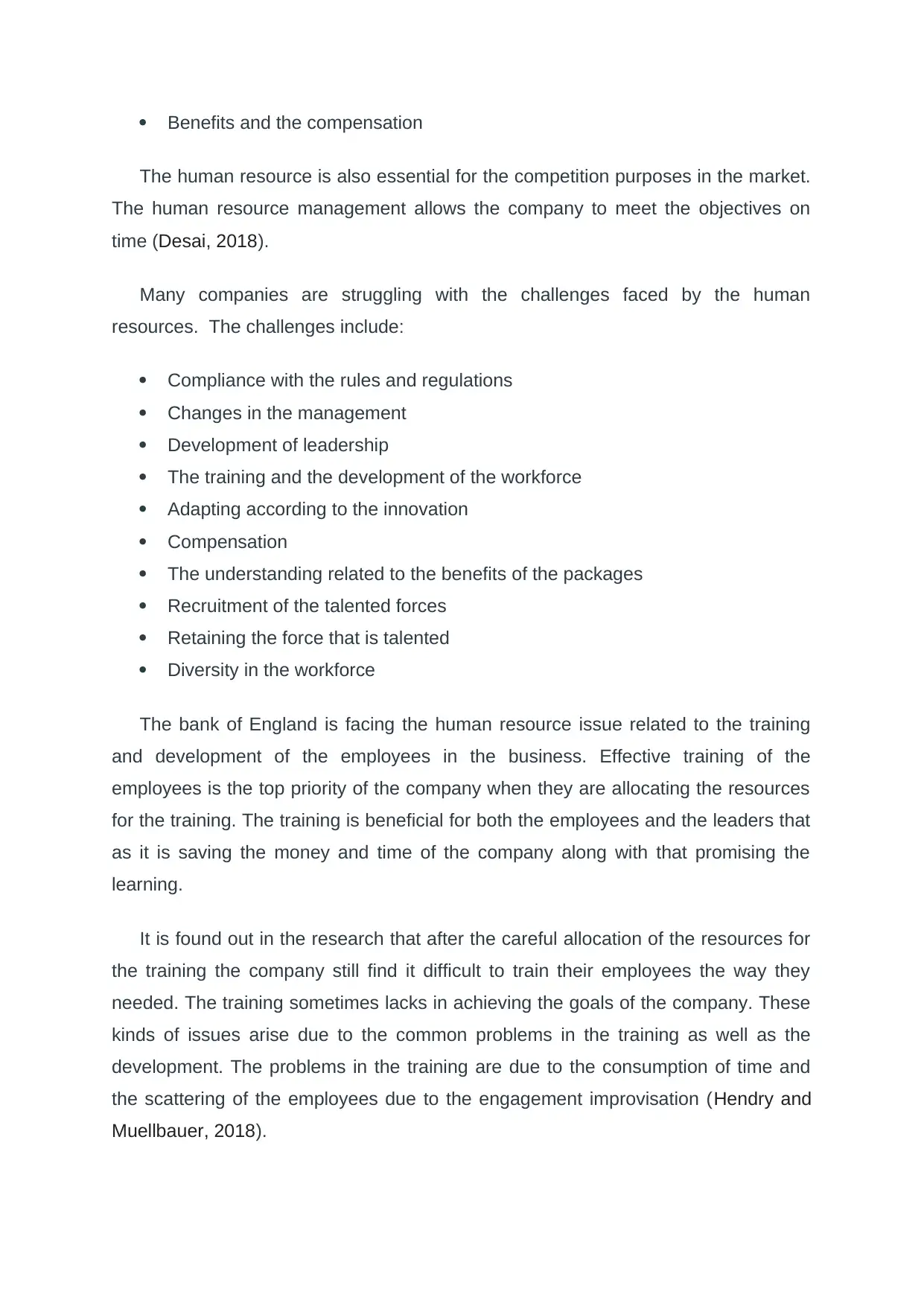
Benefits and the compensation
The human resource is also essential for the competition purposes in the market.
The human resource management allows the company to meet the objectives on
time (Desai, 2018).
Many companies are struggling with the challenges faced by the human
resources. The challenges include:
Compliance with the rules and regulations
Changes in the management
Development of leadership
The training and the development of the workforce
Adapting according to the innovation
Compensation
The understanding related to the benefits of the packages
Recruitment of the talented forces
Retaining the force that is talented
Diversity in the workforce
The bank of England is facing the human resource issue related to the training
and development of the employees in the business. Effective training of the
employees is the top priority of the company when they are allocating the resources
for the training. The training is beneficial for both the employees and the leaders that
as it is saving the money and time of the company along with that promising the
learning.
It is found out in the research that after the careful allocation of the resources for
the training the company still find it difficult to train their employees the way they
needed. The training sometimes lacks in achieving the goals of the company. These
kinds of issues arise due to the common problems in the training as well as the
development. The problems in the training are due to the consumption of time and
the scattering of the employees due to the engagement improvisation (Hendry and
Muellbauer, 2018).
The human resource is also essential for the competition purposes in the market.
The human resource management allows the company to meet the objectives on
time (Desai, 2018).
Many companies are struggling with the challenges faced by the human
resources. The challenges include:
Compliance with the rules and regulations
Changes in the management
Development of leadership
The training and the development of the workforce
Adapting according to the innovation
Compensation
The understanding related to the benefits of the packages
Recruitment of the talented forces
Retaining the force that is talented
Diversity in the workforce
The bank of England is facing the human resource issue related to the training
and development of the employees in the business. Effective training of the
employees is the top priority of the company when they are allocating the resources
for the training. The training is beneficial for both the employees and the leaders that
as it is saving the money and time of the company along with that promising the
learning.
It is found out in the research that after the careful allocation of the resources for
the training the company still find it difficult to train their employees the way they
needed. The training sometimes lacks in achieving the goals of the company. These
kinds of issues arise due to the common problems in the training as well as the
development. The problems in the training are due to the consumption of time and
the scattering of the employees due to the engagement improvisation (Hendry and
Muellbauer, 2018).
Paraphrase This Document
Need a fresh take? Get an instant paraphrase of this document with our AI Paraphraser
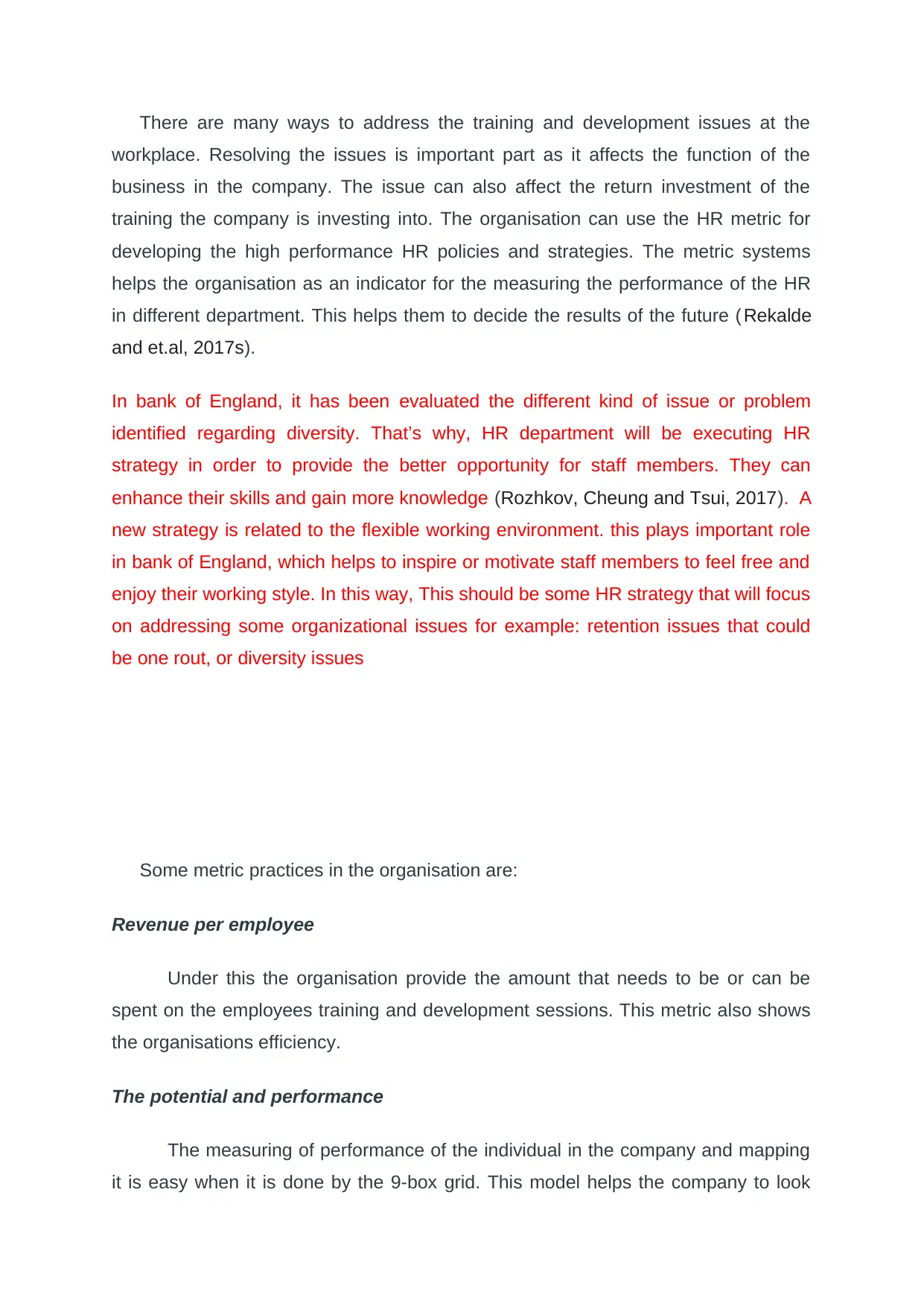
There are many ways to address the training and development issues at the
workplace. Resolving the issues is important part as it affects the function of the
business in the company. The issue can also affect the return investment of the
training the company is investing into. The organisation can use the HR metric for
developing the high performance HR policies and strategies. The metric systems
helps the organisation as an indicator for the measuring the performance of the HR
in different department. This helps them to decide the results of the future ( Rekalde
and et.al, 2017s).
In bank of England, it has been evaluated the different kind of issue or problem
identified regarding diversity. That’s why, HR department will be executing HR
strategy in order to provide the better opportunity for staff members. They can
enhance their skills and gain more knowledge (Rozhkov, Cheung and Tsui, 2017). A
new strategy is related to the flexible working environment. this plays important role
in bank of England, which helps to inspire or motivate staff members to feel free and
enjoy their working style. In this way, This should be some HR strategy that will focus
on addressing some organizational issues for example: retention issues that could
be one rout, or diversity issues
Some metric practices in the organisation are:
Revenue per employee
Under this the organisation provide the amount that needs to be or can be
spent on the employees training and development sessions. This metric also shows
the organisations efficiency.
The potential and performance
The measuring of performance of the individual in the company and mapping
it is easy when it is done by the 9-box grid. This model helps the company to look
workplace. Resolving the issues is important part as it affects the function of the
business in the company. The issue can also affect the return investment of the
training the company is investing into. The organisation can use the HR metric for
developing the high performance HR policies and strategies. The metric systems
helps the organisation as an indicator for the measuring the performance of the HR
in different department. This helps them to decide the results of the future ( Rekalde
and et.al, 2017s).
In bank of England, it has been evaluated the different kind of issue or problem
identified regarding diversity. That’s why, HR department will be executing HR
strategy in order to provide the better opportunity for staff members. They can
enhance their skills and gain more knowledge (Rozhkov, Cheung and Tsui, 2017). A
new strategy is related to the flexible working environment. this plays important role
in bank of England, which helps to inspire or motivate staff members to feel free and
enjoy their working style. In this way, This should be some HR strategy that will focus
on addressing some organizational issues for example: retention issues that could
be one rout, or diversity issues
Some metric practices in the organisation are:
Revenue per employee
Under this the organisation provide the amount that needs to be or can be
spent on the employees training and development sessions. This metric also shows
the organisations efficiency.
The potential and performance
The measuring of performance of the individual in the company and mapping
it is easy when it is done by the 9-box grid. This model helps the company to look

when the employees are underperforming, valuing the specialists, are the upcoming
potentials or the talents of the company. This model helps the company to decide
which employee should be given the training (Kotarb, 2017).
Billable hours per employee
The engagement in company requires getting the analysis that is the best way
to find the find the perfect strategy for the training and development.
Rating of the engagement
The company can check up for the rate of engagement of the employees in
the business. This will help the company as finding the level of engagement will lead
to understand the level of stress the employees is under while working. The
company can then set the training according to the needs of the employee that align
with the needs of the company. The HRM can improve the engagement as the it is
the indicator how they perform, better performance lead to success (Wawer, 2018).
The description of workplace context
The objectives of Bank of England are:
Monetary Stability
The bank influences the market rates to deliver the decisions of the Monetary
Policy Committee.
Financial Stability
The bank provide with the liquidity insurance for the critical financial services
and to reduce its cost of disruption.
The mission of the bank is to provide the people of the United Kingdom with the
good by maintaining the monetary and the financial stability. The Parliament gives
the responsibilities to the bank for their work. The balance sheet provides the
potentials or the talents of the company. This model helps the company to decide
which employee should be given the training (Kotarb, 2017).
Billable hours per employee
The engagement in company requires getting the analysis that is the best way
to find the find the perfect strategy for the training and development.
Rating of the engagement
The company can check up for the rate of engagement of the employees in
the business. This will help the company as finding the level of engagement will lead
to understand the level of stress the employees is under while working. The
company can then set the training according to the needs of the employee that align
with the needs of the company. The HRM can improve the engagement as the it is
the indicator how they perform, better performance lead to success (Wawer, 2018).
The description of workplace context
The objectives of Bank of England are:
Monetary Stability
The bank influences the market rates to deliver the decisions of the Monetary
Policy Committee.
Financial Stability
The bank provide with the liquidity insurance for the critical financial services
and to reduce its cost of disruption.
The mission of the bank is to provide the people of the United Kingdom with the
good by maintaining the monetary and the financial stability. The Parliament gives
the responsibilities to the bank for their work. The balance sheet provides the
⊘ This is a preview!⊘
Do you want full access?
Subscribe today to unlock all pages.

Trusted by 1+ million students worldwide
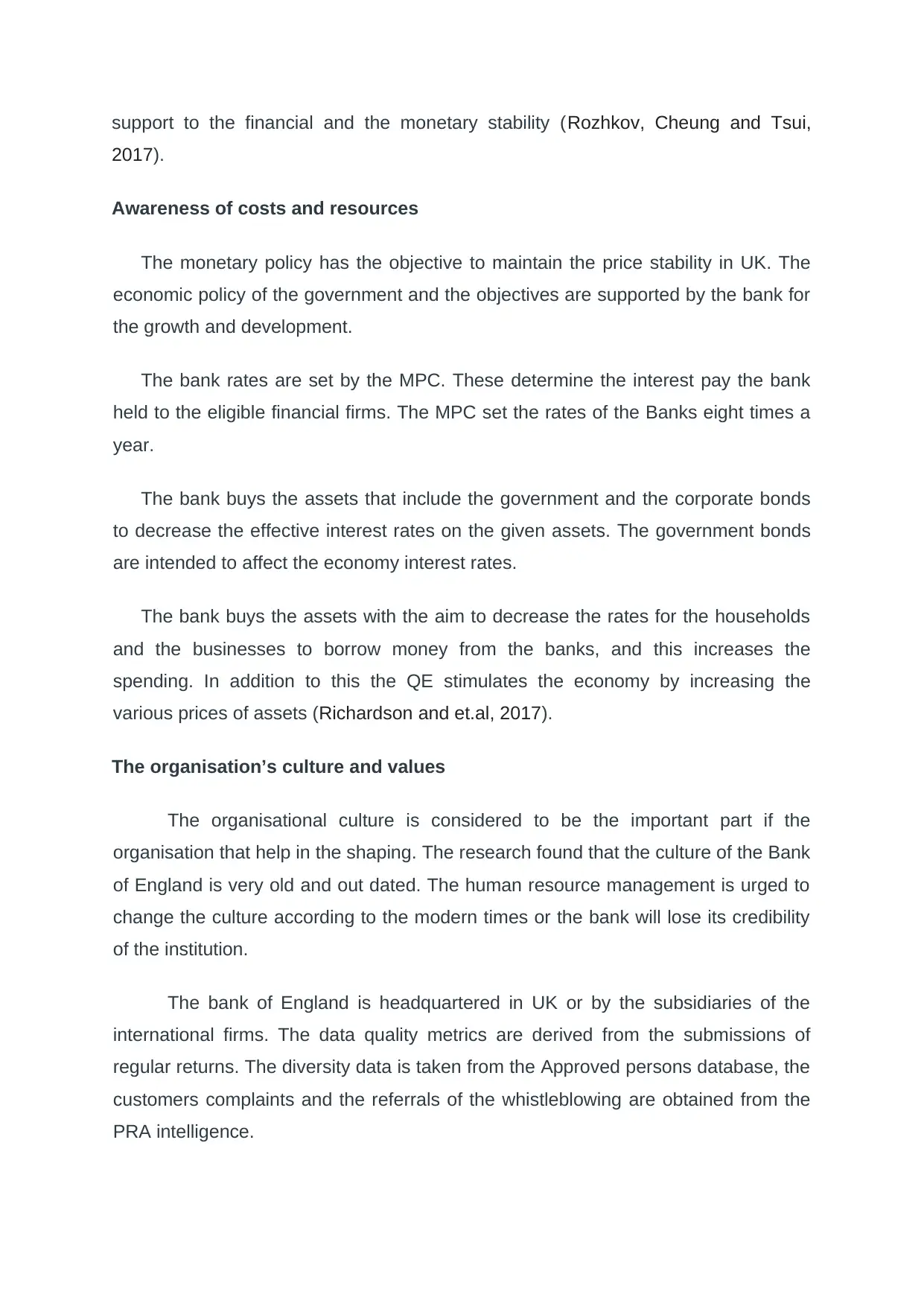
support to the financial and the monetary stability (Rozhkov, Cheung and Tsui,
2017).
Awareness of costs and resources
The monetary policy has the objective to maintain the price stability in UK. The
economic policy of the government and the objectives are supported by the bank for
the growth and development.
The bank rates are set by the MPC. These determine the interest pay the bank
held to the eligible financial firms. The MPC set the rates of the Banks eight times a
year.
The bank buys the assets that include the government and the corporate bonds
to decrease the effective interest rates on the given assets. The government bonds
are intended to affect the economy interest rates.
The bank buys the assets with the aim to decrease the rates for the households
and the businesses to borrow money from the banks, and this increases the
spending. In addition to this the QE stimulates the economy by increasing the
various prices of assets (Richardson and et.al, 2017).
The organisation’s culture and values
The organisational culture is considered to be the important part if the
organisation that help in the shaping. The research found that the culture of the Bank
of England is very old and out dated. The human resource management is urged to
change the culture according to the modern times or the bank will lose its credibility
of the institution.
The bank of England is headquartered in UK or by the subsidiaries of the
international firms. The data quality metrics are derived from the submissions of
regular returns. The diversity data is taken from the Approved persons database, the
customers complaints and the referrals of the whistleblowing are obtained from the
PRA intelligence.
2017).
Awareness of costs and resources
The monetary policy has the objective to maintain the price stability in UK. The
economic policy of the government and the objectives are supported by the bank for
the growth and development.
The bank rates are set by the MPC. These determine the interest pay the bank
held to the eligible financial firms. The MPC set the rates of the Banks eight times a
year.
The bank buys the assets that include the government and the corporate bonds
to decrease the effective interest rates on the given assets. The government bonds
are intended to affect the economy interest rates.
The bank buys the assets with the aim to decrease the rates for the households
and the businesses to borrow money from the banks, and this increases the
spending. In addition to this the QE stimulates the economy by increasing the
various prices of assets (Richardson and et.al, 2017).
The organisation’s culture and values
The organisational culture is considered to be the important part if the
organisation that help in the shaping. The research found that the culture of the Bank
of England is very old and out dated. The human resource management is urged to
change the culture according to the modern times or the bank will lose its credibility
of the institution.
The bank of England is headquartered in UK or by the subsidiaries of the
international firms. The data quality metrics are derived from the submissions of
regular returns. The diversity data is taken from the Approved persons database, the
customers complaints and the referrals of the whistleblowing are obtained from the
PRA intelligence.
Paraphrase This Document
Need a fresh take? Get an instant paraphrase of this document with our AI Paraphraser
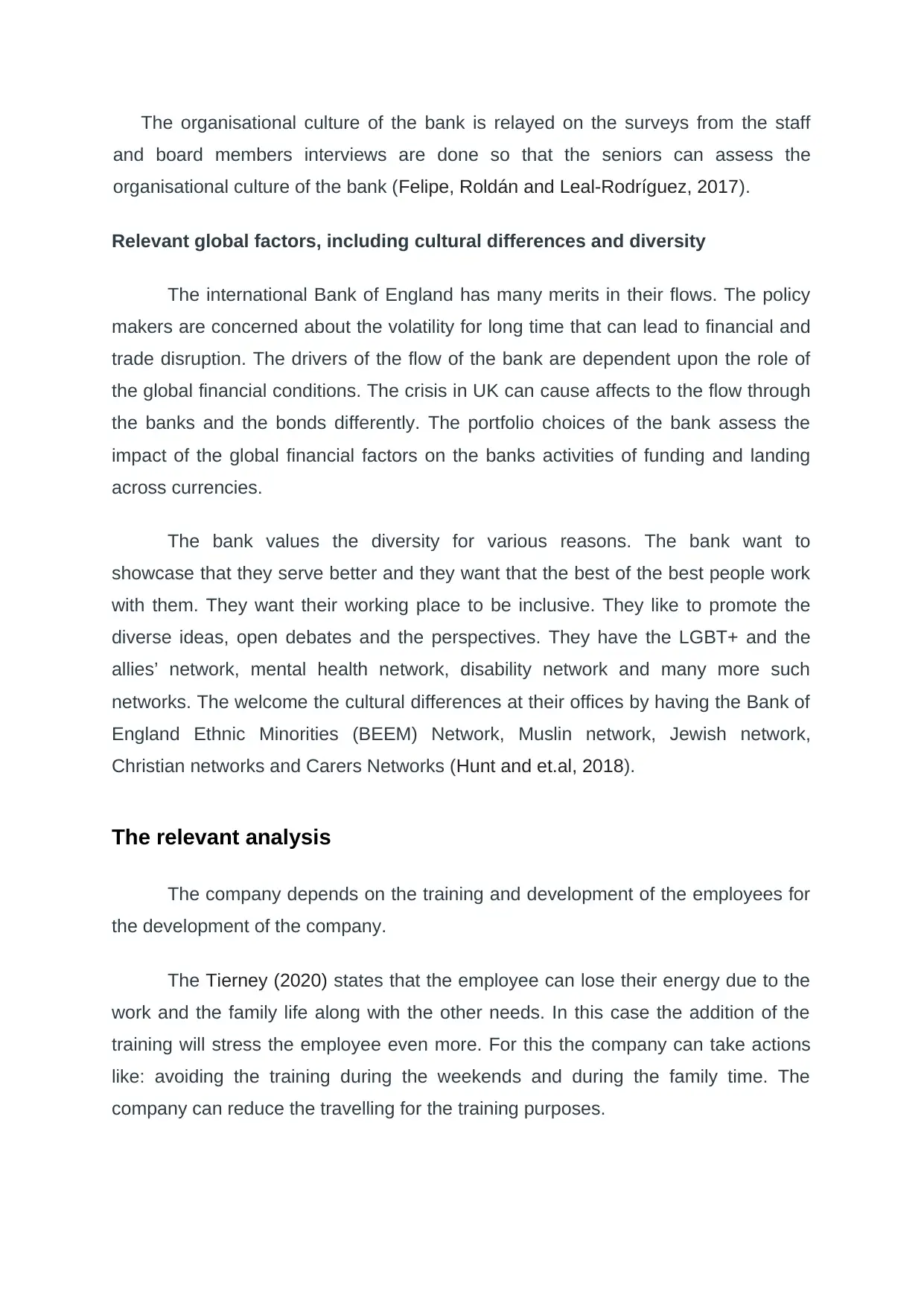
The organisational culture of the bank is relayed on the surveys from the staff
and board members interviews are done so that the seniors can assess the
organisational culture of the bank (Felipe, Roldán and Leal-Rodríguez, 2017).
Relevant global factors, including cultural differences and diversity
The international Bank of England has many merits in their flows. The policy
makers are concerned about the volatility for long time that can lead to financial and
trade disruption. The drivers of the flow of the bank are dependent upon the role of
the global financial conditions. The crisis in UK can cause affects to the flow through
the banks and the bonds differently. The portfolio choices of the bank assess the
impact of the global financial factors on the banks activities of funding and landing
across currencies.
The bank values the diversity for various reasons. The bank want to
showcase that they serve better and they want that the best of the best people work
with them. They want their working place to be inclusive. They like to promote the
diverse ideas, open debates and the perspectives. They have the LGBT+ and the
allies’ network, mental health network, disability network and many more such
networks. The welcome the cultural differences at their offices by having the Bank of
England Ethnic Minorities (BEEM) Network, Muslin network, Jewish network,
Christian networks and Carers Networks (Hunt and et.al, 2018).
The relevant analysis
The company depends on the training and development of the employees for
the development of the company.
The Tierney (2020) states that the employee can lose their energy due to the
work and the family life along with the other needs. In this case the addition of the
training will stress the employee even more. For this the company can take actions
like: avoiding the training during the weekends and during the family time. The
company can reduce the travelling for the training purposes.
and board members interviews are done so that the seniors can assess the
organisational culture of the bank (Felipe, Roldán and Leal-Rodríguez, 2017).
Relevant global factors, including cultural differences and diversity
The international Bank of England has many merits in their flows. The policy
makers are concerned about the volatility for long time that can lead to financial and
trade disruption. The drivers of the flow of the bank are dependent upon the role of
the global financial conditions. The crisis in UK can cause affects to the flow through
the banks and the bonds differently. The portfolio choices of the bank assess the
impact of the global financial factors on the banks activities of funding and landing
across currencies.
The bank values the diversity for various reasons. The bank want to
showcase that they serve better and they want that the best of the best people work
with them. They want their working place to be inclusive. They like to promote the
diverse ideas, open debates and the perspectives. They have the LGBT+ and the
allies’ network, mental health network, disability network and many more such
networks. The welcome the cultural differences at their offices by having the Bank of
England Ethnic Minorities (BEEM) Network, Muslin network, Jewish network,
Christian networks and Carers Networks (Hunt and et.al, 2018).
The relevant analysis
The company depends on the training and development of the employees for
the development of the company.
The Tierney (2020) states that the employee can lose their energy due to the
work and the family life along with the other needs. In this case the addition of the
training will stress the employee even more. For this the company can take actions
like: avoiding the training during the weekends and during the family time. The
company can reduce the travelling for the training purposes.
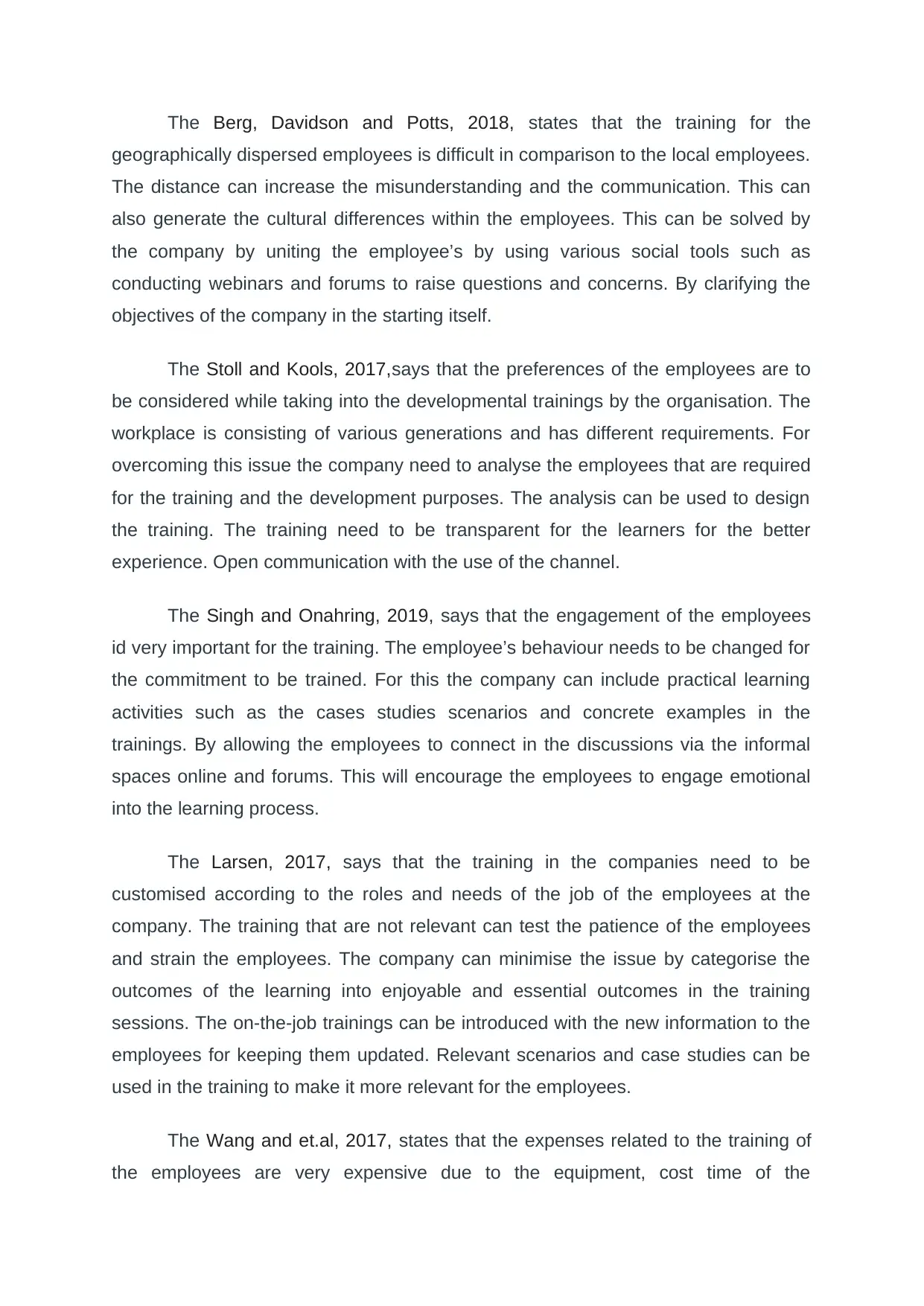
The Berg, Davidson and Potts, 2018, states that the training for the
geographically dispersed employees is difficult in comparison to the local employees.
The distance can increase the misunderstanding and the communication. This can
also generate the cultural differences within the employees. This can be solved by
the company by uniting the employee’s by using various social tools such as
conducting webinars and forums to raise questions and concerns. By clarifying the
objectives of the company in the starting itself.
The Stoll and Kools, 2017,says that the preferences of the employees are to
be considered while taking into the developmental trainings by the organisation. The
workplace is consisting of various generations and has different requirements. For
overcoming this issue the company need to analyse the employees that are required
for the training and the development purposes. The analysis can be used to design
the training. The training need to be transparent for the learners for the better
experience. Open communication with the use of the channel.
The Singh and Onahring, 2019, says that the engagement of the employees
id very important for the training. The employee’s behaviour needs to be changed for
the commitment to be trained. For this the company can include practical learning
activities such as the cases studies scenarios and concrete examples in the
trainings. By allowing the employees to connect in the discussions via the informal
spaces online and forums. This will encourage the employees to engage emotional
into the learning process.
The Larsen, 2017, says that the training in the companies need to be
customised according to the roles and needs of the job of the employees at the
company. The training that are not relevant can test the patience of the employees
and strain the employees. The company can minimise the issue by categorise the
outcomes of the learning into enjoyable and essential outcomes in the training
sessions. The on-the-job trainings can be introduced with the new information to the
employees for keeping them updated. Relevant scenarios and case studies can be
used in the training to make it more relevant for the employees.
The Wang and et.al, 2017, states that the expenses related to the training of
the employees are very expensive due to the equipment, cost time of the
geographically dispersed employees is difficult in comparison to the local employees.
The distance can increase the misunderstanding and the communication. This can
also generate the cultural differences within the employees. This can be solved by
the company by uniting the employee’s by using various social tools such as
conducting webinars and forums to raise questions and concerns. By clarifying the
objectives of the company in the starting itself.
The Stoll and Kools, 2017,says that the preferences of the employees are to
be considered while taking into the developmental trainings by the organisation. The
workplace is consisting of various generations and has different requirements. For
overcoming this issue the company need to analyse the employees that are required
for the training and the development purposes. The analysis can be used to design
the training. The training need to be transparent for the learners for the better
experience. Open communication with the use of the channel.
The Singh and Onahring, 2019, says that the engagement of the employees
id very important for the training. The employee’s behaviour needs to be changed for
the commitment to be trained. For this the company can include practical learning
activities such as the cases studies scenarios and concrete examples in the
trainings. By allowing the employees to connect in the discussions via the informal
spaces online and forums. This will encourage the employees to engage emotional
into the learning process.
The Larsen, 2017, says that the training in the companies need to be
customised according to the roles and needs of the job of the employees at the
company. The training that are not relevant can test the patience of the employees
and strain the employees. The company can minimise the issue by categorise the
outcomes of the learning into enjoyable and essential outcomes in the training
sessions. The on-the-job trainings can be introduced with the new information to the
employees for keeping them updated. Relevant scenarios and case studies can be
used in the training to make it more relevant for the employees.
The Wang and et.al, 2017, states that the expenses related to the training of
the employees are very expensive due to the equipment, cost time of the
⊘ This is a preview!⊘
Do you want full access?
Subscribe today to unlock all pages.

Trusted by 1+ million students worldwide
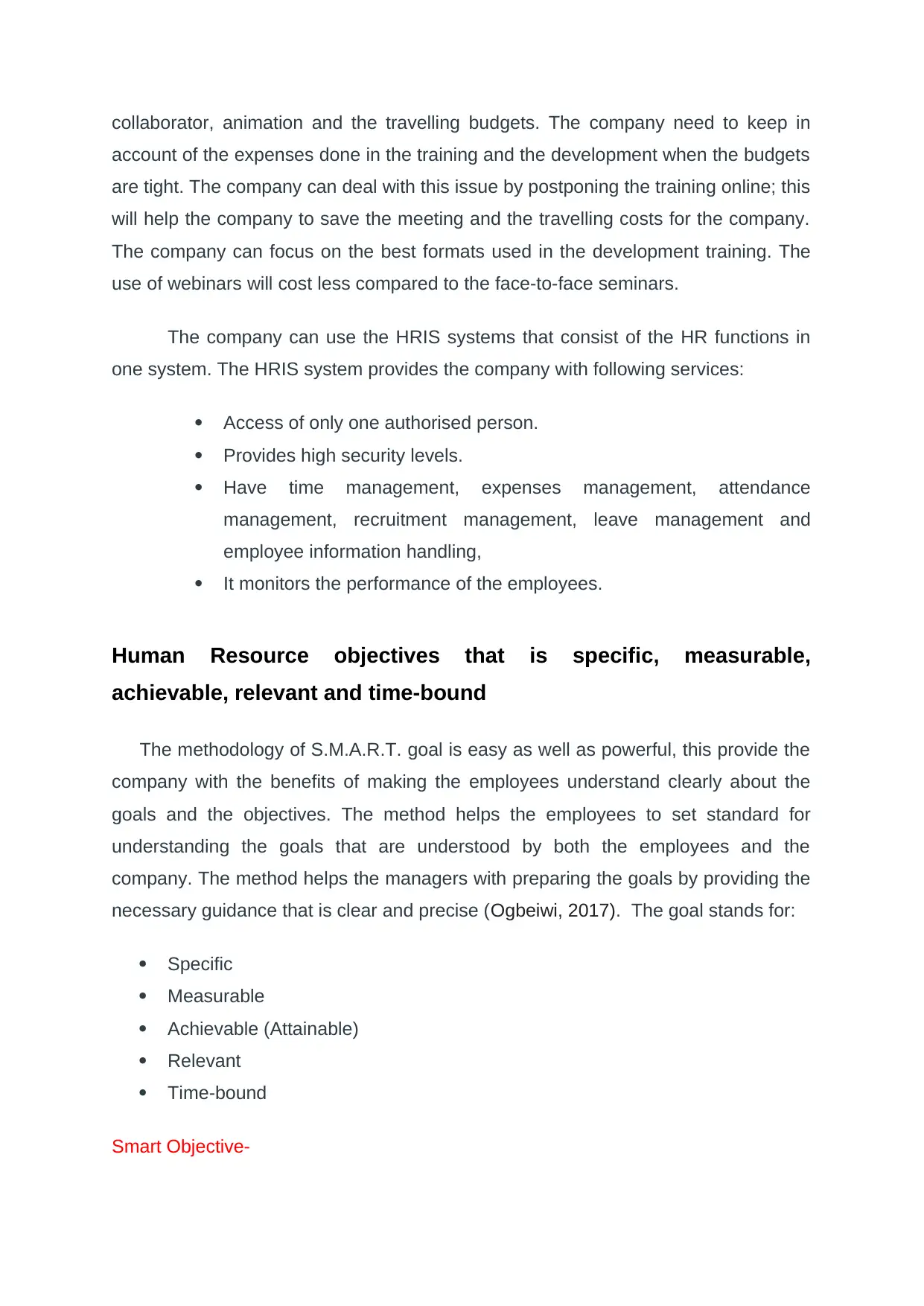
collaborator, animation and the travelling budgets. The company need to keep in
account of the expenses done in the training and the development when the budgets
are tight. The company can deal with this issue by postponing the training online; this
will help the company to save the meeting and the travelling costs for the company.
The company can focus on the best formats used in the development training. The
use of webinars will cost less compared to the face-to-face seminars.
The company can use the HRIS systems that consist of the HR functions in
one system. The HRIS system provides the company with following services:
Access of only one authorised person.
Provides high security levels.
Have time management, expenses management, attendance
management, recruitment management, leave management and
employee information handling,
It monitors the performance of the employees.
Human Resource objectives that is specific, measurable,
achievable, relevant and time-bound
The methodology of S.M.A.R.T. goal is easy as well as powerful, this provide the
company with the benefits of making the employees understand clearly about the
goals and the objectives. The method helps the employees to set standard for
understanding the goals that are understood by both the employees and the
company. The method helps the managers with preparing the goals by providing the
necessary guidance that is clear and precise (Ogbeiwi, 2017). The goal stands for:
Specific
Measurable
Achievable (Attainable)
Relevant
Time-bound
Smart Objective-
account of the expenses done in the training and the development when the budgets
are tight. The company can deal with this issue by postponing the training online; this
will help the company to save the meeting and the travelling costs for the company.
The company can focus on the best formats used in the development training. The
use of webinars will cost less compared to the face-to-face seminars.
The company can use the HRIS systems that consist of the HR functions in
one system. The HRIS system provides the company with following services:
Access of only one authorised person.
Provides high security levels.
Have time management, expenses management, attendance
management, recruitment management, leave management and
employee information handling,
It monitors the performance of the employees.
Human Resource objectives that is specific, measurable,
achievable, relevant and time-bound
The methodology of S.M.A.R.T. goal is easy as well as powerful, this provide the
company with the benefits of making the employees understand clearly about the
goals and the objectives. The method helps the employees to set standard for
understanding the goals that are understood by both the employees and the
company. The method helps the managers with preparing the goals by providing the
necessary guidance that is clear and precise (Ogbeiwi, 2017). The goal stands for:
Specific
Measurable
Achievable (Attainable)
Relevant
Time-bound
Smart Objective-
Paraphrase This Document
Need a fresh take? Get an instant paraphrase of this document with our AI Paraphraser
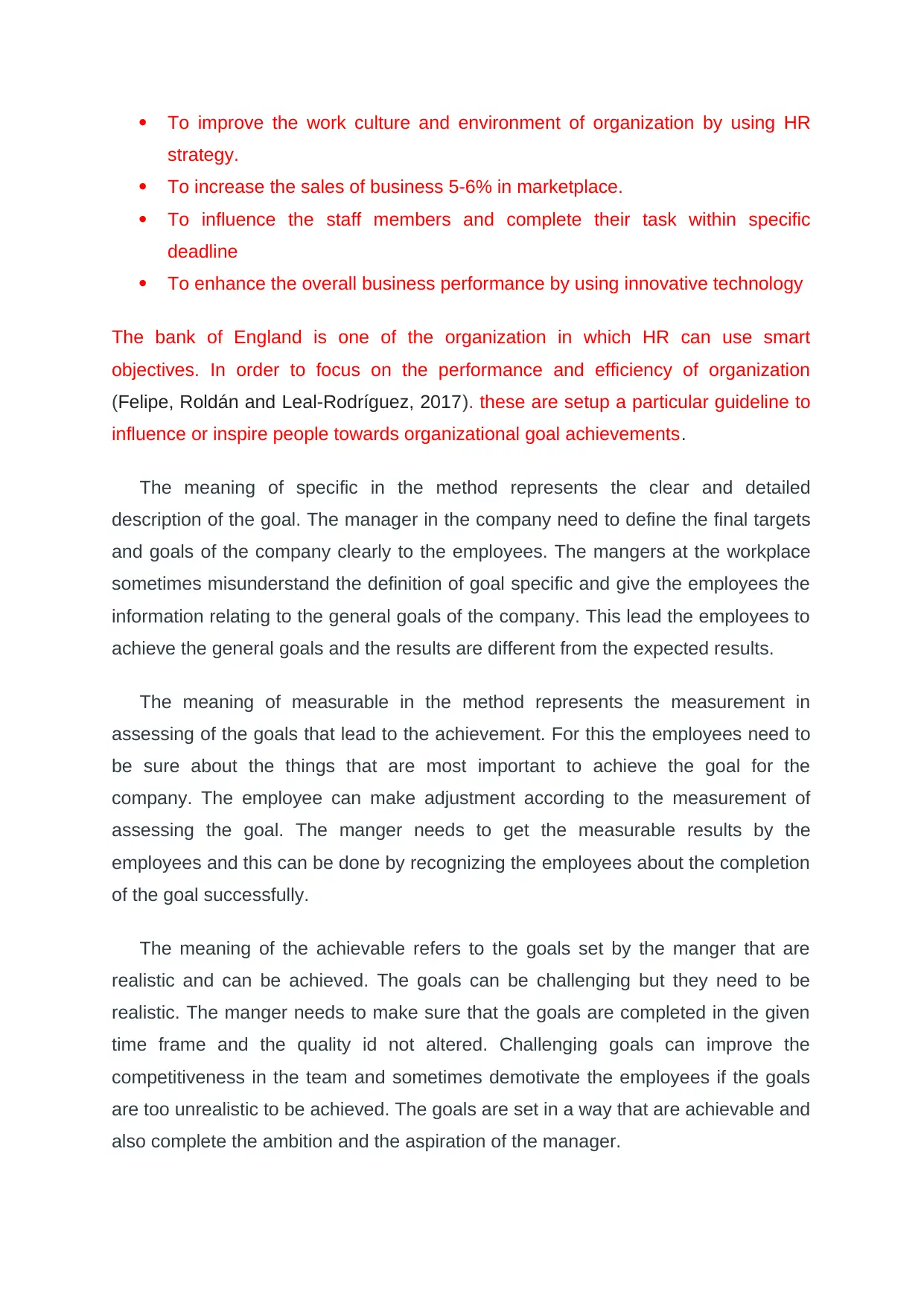
To improve the work culture and environment of organization by using HR
strategy.
To increase the sales of business 5-6% in marketplace.
To influence the staff members and complete their task within specific
deadline
To enhance the overall business performance by using innovative technology
The bank of England is one of the organization in which HR can use smart
objectives. In order to focus on the performance and efficiency of organization
(Felipe, Roldán and Leal-Rodríguez, 2017). these are setup a particular guideline to
influence or inspire people towards organizational goal achievements.
The meaning of specific in the method represents the clear and detailed
description of the goal. The manager in the company need to define the final targets
and goals of the company clearly to the employees. The mangers at the workplace
sometimes misunderstand the definition of goal specific and give the employees the
information relating to the general goals of the company. This lead the employees to
achieve the general goals and the results are different from the expected results.
The meaning of measurable in the method represents the measurement in
assessing of the goals that lead to the achievement. For this the employees need to
be sure about the things that are most important to achieve the goal for the
company. The employee can make adjustment according to the measurement of
assessing the goal. The manger needs to get the measurable results by the
employees and this can be done by recognizing the employees about the completion
of the goal successfully.
The meaning of the achievable refers to the goals set by the manger that are
realistic and can be achieved. The goals can be challenging but they need to be
realistic. The manger needs to make sure that the goals are completed in the given
time frame and the quality id not altered. Challenging goals can improve the
competitiveness in the team and sometimes demotivate the employees if the goals
are too unrealistic to be achieved. The goals are set in a way that are achievable and
also complete the ambition and the aspiration of the manager.
strategy.
To increase the sales of business 5-6% in marketplace.
To influence the staff members and complete their task within specific
deadline
To enhance the overall business performance by using innovative technology
The bank of England is one of the organization in which HR can use smart
objectives. In order to focus on the performance and efficiency of organization
(Felipe, Roldán and Leal-Rodríguez, 2017). these are setup a particular guideline to
influence or inspire people towards organizational goal achievements.
The meaning of specific in the method represents the clear and detailed
description of the goal. The manager in the company need to define the final targets
and goals of the company clearly to the employees. The mangers at the workplace
sometimes misunderstand the definition of goal specific and give the employees the
information relating to the general goals of the company. This lead the employees to
achieve the general goals and the results are different from the expected results.
The meaning of measurable in the method represents the measurement in
assessing of the goals that lead to the achievement. For this the employees need to
be sure about the things that are most important to achieve the goal for the
company. The employee can make adjustment according to the measurement of
assessing the goal. The manger needs to get the measurable results by the
employees and this can be done by recognizing the employees about the completion
of the goal successfully.
The meaning of the achievable refers to the goals set by the manger that are
realistic and can be achieved. The goals can be challenging but they need to be
realistic. The manger needs to make sure that the goals are completed in the given
time frame and the quality id not altered. Challenging goals can improve the
competitiveness in the team and sometimes demotivate the employees if the goals
are too unrealistic to be achieved. The goals are set in a way that are achievable and
also complete the ambition and the aspiration of the manager.
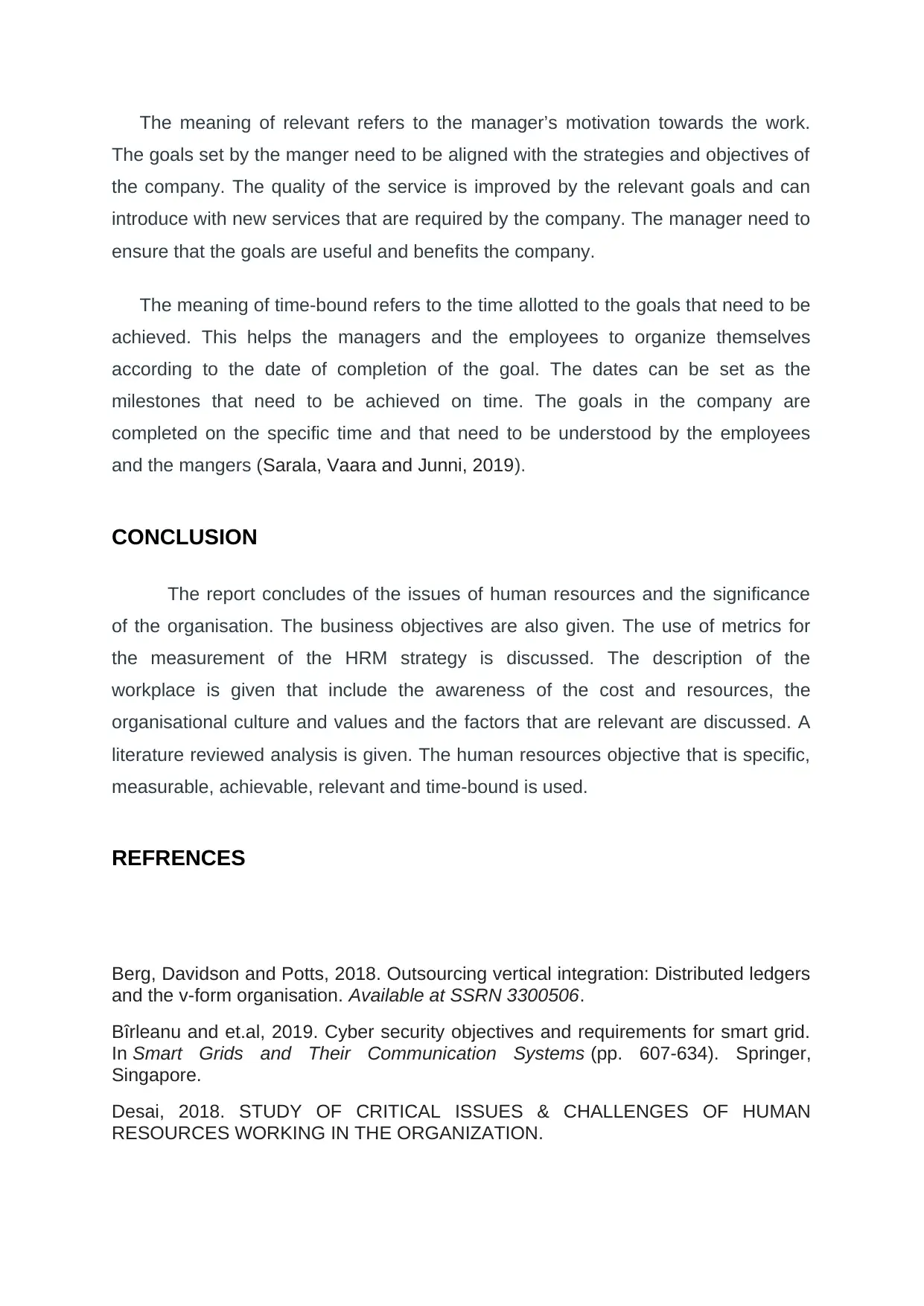
The meaning of relevant refers to the manager’s motivation towards the work.
The goals set by the manger need to be aligned with the strategies and objectives of
the company. The quality of the service is improved by the relevant goals and can
introduce with new services that are required by the company. The manager need to
ensure that the goals are useful and benefits the company.
The meaning of time-bound refers to the time allotted to the goals that need to be
achieved. This helps the managers and the employees to organize themselves
according to the date of completion of the goal. The dates can be set as the
milestones that need to be achieved on time. The goals in the company are
completed on the specific time and that need to be understood by the employees
and the mangers (Sarala, Vaara and Junni, 2019).
CONCLUSION
The report concludes of the issues of human resources and the significance
of the organisation. The business objectives are also given. The use of metrics for
the measurement of the HRM strategy is discussed. The description of the
workplace is given that include the awareness of the cost and resources, the
organisational culture and values and the factors that are relevant are discussed. A
literature reviewed analysis is given. The human resources objective that is specific,
measurable, achievable, relevant and time-bound is used.
REFRENCES
Berg, Davidson and Potts, 2018. Outsourcing vertical integration: Distributed ledgers
and the v-form organisation. Available at SSRN 3300506.
Bîrleanu and et.al, 2019. Cyber security objectives and requirements for smart grid.
In Smart Grids and Their Communication Systems (pp. 607-634). Springer,
Singapore.
Desai, 2018. STUDY OF CRITICAL ISSUES & CHALLENGES OF HUMAN
RESOURCES WORKING IN THE ORGANIZATION.
The goals set by the manger need to be aligned with the strategies and objectives of
the company. The quality of the service is improved by the relevant goals and can
introduce with new services that are required by the company. The manager need to
ensure that the goals are useful and benefits the company.
The meaning of time-bound refers to the time allotted to the goals that need to be
achieved. This helps the managers and the employees to organize themselves
according to the date of completion of the goal. The dates can be set as the
milestones that need to be achieved on time. The goals in the company are
completed on the specific time and that need to be understood by the employees
and the mangers (Sarala, Vaara and Junni, 2019).
CONCLUSION
The report concludes of the issues of human resources and the significance
of the organisation. The business objectives are also given. The use of metrics for
the measurement of the HRM strategy is discussed. The description of the
workplace is given that include the awareness of the cost and resources, the
organisational culture and values and the factors that are relevant are discussed. A
literature reviewed analysis is given. The human resources objective that is specific,
measurable, achievable, relevant and time-bound is used.
REFRENCES
Berg, Davidson and Potts, 2018. Outsourcing vertical integration: Distributed ledgers
and the v-form organisation. Available at SSRN 3300506.
Bîrleanu and et.al, 2019. Cyber security objectives and requirements for smart grid.
In Smart Grids and Their Communication Systems (pp. 607-634). Springer,
Singapore.
Desai, 2018. STUDY OF CRITICAL ISSUES & CHALLENGES OF HUMAN
RESOURCES WORKING IN THE ORGANIZATION.
⊘ This is a preview!⊘
Do you want full access?
Subscribe today to unlock all pages.

Trusted by 1+ million students worldwide
1 out of 14
Related Documents
Your All-in-One AI-Powered Toolkit for Academic Success.
+13062052269
info@desklib.com
Available 24*7 on WhatsApp / Email
![[object Object]](/_next/static/media/star-bottom.7253800d.svg)
Unlock your academic potential
Copyright © 2020–2025 A2Z Services. All Rights Reserved. Developed and managed by ZUCOL.




